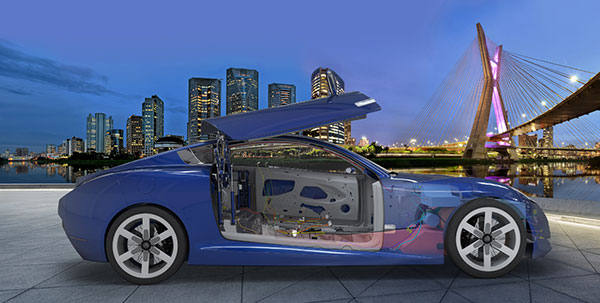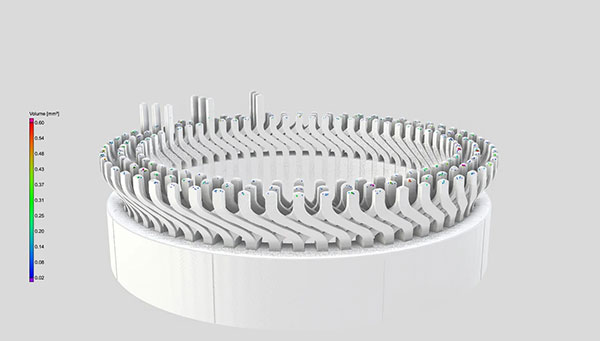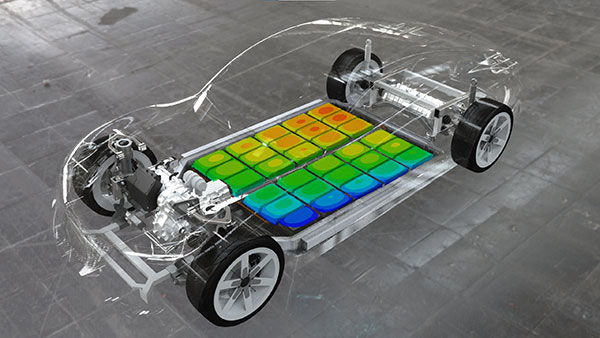Automotive Design: Speed Time to Market
It’s important for automotive OEMs, in an effort to stay competitive, to adopt a flexible and agile manufacturing approach to adapt to new business models, experts say.

Dassault Systèmes aims to help customers understand and design materials, products, factories and services with virtual twin technology optimized for sustainability. Image courtesy of Dassault Systèmes.
Latest News
September 6, 2022
The automotive market traditionally has a long time from design to prototype tooling and eventually to production and rollout. In between these steps are many material changes, approvals, disapprovals and iterations to design the next model that can stand up to fierce competition and now many new technologies.
Additionally, there is great pressure to maintain sustainable designs with low emissions and greater fuel economy, while maintaining attractive designs and human factors.
Several automotive startups and technology companies, however, have found ways to speed up the overall process to generate innovative design, simulation, prototyping, testing and manufacturing technologies using new technologies that not only improve the final product, but provide a competitive edge.
Rick Sturgeon is a senior director of the transportation and mobility industry at Dassault Systèmes. He says they are seeing many legacy automotive companies and startups arrive at the same conclusion: the complexity of modern vehicles means a shift in the design and manufacturing process.

Complexities of modern vehicles requires a shift in the design and manufacturing process. A traditional file-based design process cannot keep up. Image courtesy of Dassault Systèmes.
“For designing the vehicles of tomorrow—including the transition from combustion to electric, the increase in sophisticated electronics and software, the digital integration of the driver and the autonomous vehicle connection to the city—a new approach is required to effectively enable the entire development process. The traditional file-based design process simply cannot keep up,” says Sturgeon.
Sturgeon notes that electric vehicle (EV) manufacturers are instead putting their designs into a cloud-based product innovation platform, where a single source of truth can be accessed by the entire organization. This approach supercharges collaboration and eliminates version control issues.
“By having all design data and functions on a single platform with integrated simulation solutions, engineers can create virtual twins of their vehicles, enabling significant reductions in time to market and cost savings over the test and validation phases,” Sturgeon says. “With virtual twins, teams are able to simulate assembly procedures before machinery is deployed to a factory and run testing and validation for every subsystem before a single prototype is manufactured.”
Focus on Electric Vehicles
Johannes Mann is the director of global industry processes for Hexagon Manufacturing Intelligence in Heidelberg, Germany. He says that traditionally, part and product development took place in sequential evolutionary steps. He emphasizes the overarching focus on EVs as automotive is searching for its solid ground to supply a world of EV.

Auto makers need to shift development efforts into the digital world to save the cost of intense physical development and to speed up the overall development. Image courtesy of Hexagon.
“The transformation now [towards] EV is driven by many different forces such as emission regulations and laws,” explains Mann. “A race has started between the manufacturers to become the first [original equipment manufacturer (OEM)] to be fully electric.”
He continues, “Furthermore, new players entered the market utilizing the disruptive wave, which made it possible to enter the market without having know-how in combustion engines, a former core competence.”
To stay on top of the accelerated transition, Mann suggests that automakers will need to shift development efforts into the digital world to save the cost of rigorous physical development and to speed up overall development. For instance, iterations will need to be executed quickly and, if possible, in parallel.
“Therefore, generative design, simulation as well as virtual metrology and [Design of Experiments (DoE)] studies based on [artificial intelligence (AI)] are utilized to bring momentum to the development,” Mann says.
Sturgeon says battery-powered EVs represent the future of transportation, whether the battery-powered family car or the fuel cell/battery-powered long-haul truck.
“The reasons for battery-powered EV popularity are clear: higher performance, simpler maintenance and operational cost reductions,” says Sturgeon. “Tightening government regulations on emissions, combined with unstable petroleum supply and costs, also factor into growing demand for EVs. Add to this a growing sense among the driving public around climate challenges, [and] it’s no wonder that EV adoption is on the rise.”
The fluidity of these market niches calls for flexibility and collaboration. “In this rapidly evolving market, automotive OEMs wishing to remain competitive need to adopt a flexible manufacturing approach, as well as an agile structure to adapt to new business models,” says Sturgeon. “They must either develop in-house or partner with suppliers to manufacture large quantities of high-energy density batteries.”
Additionally, the batteries must be safe, quick to charge and provide better ranges than what is available with gas and diesel alternatives, according to Sturgeon.
Energy storage is a critical component to consider in EV design, and designers have many constraints and features that impact the design of batteries.
“Battery design challenges include building virtual simulations of battery cell materials for trade-off across competing [key performance indicators (KPIs)], including range, fast charge, safety, cost and durability. Additionally, OEMs must consider the multi-scale simulation of cells from nano to engineering scales and multiphysics simulation to optimize the cell, module and pack engineering,” says Sturgeon.
“To be at the forefront of development, OEMs are focusing on developing next-generation solid-state batteries with a stable manufacturing process that reduces scrap, is sustainable and results in a low carbon footprint,” Sturgeon adds.
Designing eMotors Using the Hairpin Concept
Hexagon’s Mann explains their approach to EV design and specifically eMotor design using the hairpin concept. This new way of manufacturing the stators must be frequently assessed to ensure high quality and to gain experience as fast as possible, according to Mann. Crucial to success is, on one side, the correct shape of each single hairpin and on the other side the connection of the hairpins, the hairpin welds.

According to Hexagon’s approach to this concept, hairpins are manufactured by bending wire and covering much of the metal (in most cases copper) with an insulating layer. The pins are not rigid in a free state, which makes it hard to measure them without excessive fixturing.
“One way is to measure a number of functionally good pins and generate a virtual master model based on them,” explains Mann. “Having acquired a master model, a contactless shop-floor photogrammetry inspection system (end of line or inbound) can be done rapidly in 10 seconds (data acquisition & analysis) to judge if the part is okay or not okay, but also to feed [statistical process control (SPC)] systems to control the manufacturing processes.”
However, Mann explains that the hairpin design approach has challenges especially when it comes to welds and joints.
“The joining operation is done by laser welding in most cases,” Mann says. “It is very important to have an appropriate welding to ensure structural strength of the connection but also to let the current flow from one pin to the other. Having three-digit numbers of welding operations per stator, processes need to be very capable to be sure all connections are done with high quality.”
“Despite all efforts, porosity arises in these welding balls, which endangers the functions of the part,” Mann continues.
Porosity directly impacts the structural strength of the connection, as Mann explains. But more important, he says, is that porosity eats up the conducting material, which enables the current to flow.
“The more porosity shows up, the less material guides the current to the other pin,” Mann continues. “As a result, high current densities appear and lead to thermal issues and failure of the part.
“To control production processes, stators are CT scanned and inspected to check if there is porosity and, if yes, a decision is triggered if it is within tolerance or not,” Mann adds. “By doing so, non-conformities can be determined even before they reach the specification boundaries and processes can be adjusted accordingly.”
Designing With an MBSE Focus
Sturgeon emphasizes the use of model-based systems engineering (MBSE) as a useful basis in an automotive design approach.
“We have seen an increased use of comprehensive MBSE, in both our legacy and new customer base for EV and sustainable mobility development,” says Sturgeon. “From new materials for lightweighting, to better acoustics/aerodynamics, to modeling a battery-driven powertrain, and then incorporating all the elements of connected/autonomous vehicle tech, we can no longer view these vehicles as collections of individual components that are assembled. They are complex systems of systems and need to be developed accordingly.”

Vehicle development today, Sturgeon adds, starts with using MBSE to create requirements as a mathematical model that are maintained and updated throughout the development cycle, including after service, and are available to all.
“The MBSE approach has been leveraged for many years by our aerospace customers, which we have integrated into our overall systems engineering, simulation and requirements validation process within our 3DEXPERIENCE platform,” Sturgeon says. “This holistic approach in overall vehicle development, mobility and customer experience as a living requirements model versus a static requirements document is an industry game-changer and will enable better management of all this increased complexity to potentially deliver a vehicle in quicker cycle time, and for lower development costs, while providing an enhanced customer experience.”
New Age Tools for New Age Design
The automotive market is always in a state of flux. Designs constantly change, influenced by consumers, but also regulators and public policy that pushes the importance of sustainability, fuel efficiency and other factors in today’s globally competitive market are all constantly evolving.
As these changes take place and shape the new wave of automotive designers, more tools and design approaches will take shape to meet the challenges of this industry and its global market that needs all accessible tools to help them design better, faster and more reliable and sustainable automobiles.
More Dassault Systemes Coverage

More Hexagon Manufacturing Intelligence Coverage
Subscribe to our FREE magazine, FREE email newsletters or both!
Latest News
About the Author
Jim Romeo is a freelance writer based in Chesapeake, VA. Send e-mail about this article to [email protected].
Follow DE






